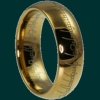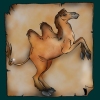Namnöversättning
| Tolkien (första förekomst) |
Åke Ohlmarks | Erik Andersson | Kamelen |
|---|---|---|---|
| Isenmouthe (Bok VI, kapitel 2: Skuggornas land) |
Isens gap, Isengapet | Isengap | Isengap, Isengapet |
| Tolkiens översättningsguide | |||
| Isengard and Isenmouthe. These names were intended to represent translations into the Common Speech of the Elvish names Angrenost and Carach Angren, but ones made at so early a date that at the period of the tale they had become archaic in form and their original meanings were obscured. They can therefore be left unchanged, though translation (of one or both elements in either name) would be suitable, and I think desirable when the language of translation is Germanic, possessing related elements. Isen is an old variant form in English of iron; gard a Germanic word meaning 'enclosure', especially one round a dwelling or group of buildings; and mouthe a derivative of mouth, representing Old English m?tha (from m?th 'mouth') 'opening', especially used of the mouths of rivers, but also applied to other openings (not parts of a body). Isengard 'the Iron-court' was so called because of the great hardness of the stone in that place and especially in the central tower. The Isenmouthe was so called because of the great fence of pointed iron posts that closed the gap leading into Udûn, like teeth in jaws (see III 197, 209). In the Dutch and Swedish versions Isengard is left unchanged. For Isenmouthe the Dutch uses Isenmonde, translating or assimilating to Dutch only the second element (a more complete translation to Ijzermonde would seem to me better). The Swedish renders it Isensgap, which is incorrect, since Isen is not a proper name but adjectival. The gard element appears in Old Norse garðr, whence current or dialectal Swedish gård, Danish gaard, and English garth (beside the original English form yard); this, though usually of more lowly associations (as English farmyard), appears for instance in Old Norse Ás-garðr, now widely known as Asgard in mythology. The word was early lost in German, except in Old High German mittin- or mittil-gart (the inhabited lands of Men) = Old Norse mið-garðr, and Old English middan-geard: see Middle-earth. Would not this old element in German form -gart be suitable for a translation or assimilation to German such as Eisengart? Of -mouthe the German equivalent appears to be mündung (or in place-names -münde ); in Scandinavian, Danish munding, Swedish mynning. Note. Whatever form is used in Isengard must also be used in the name of the River Isen, since the river-name was derived from Isengard, in which it had its source. |
|||
| Kommentar | |||
| Den svenska motsvarigheten till Isenmouthe skulle nog bli ungefär "Isenmynne" (ändelsen -mynne eller vanligare -mynnet förekommer i en del ortnamn), eller för all del "Isenmynning", som Tolkien föreslår. Och visst kan man använda det ordet om öppningar som inte är vattendrags utlopp även på svenska – till exempel grottmynning eller gevärsmynning. Men min känsla är att ordet har en mycket svagare koppling till en anatomisk mun än på engelska. Eftersom det här tydligen är tänderna runt "munnen" som givit upphov till namnet så blir bildspråket alltför otydligt med någon variant av -mynning. Då är Ohlmarks och Anderssons -gap klart bättre. (Dock självklart inte Isensgap!)
I original förekommer båda formerna Isenmouthe och the Isenmouthe. På de sistnämnda ställena känns det just nu som om det funkar bra med bestämd form, "Isengapet", även på svenska. Men jag skall fundera på det ett varv till innan jag slutgiltigt bestämmer mig. Vad gäller (icke-)översättningen av Isen-, se Isengard. Senast uppdaterad: 2023-12-06 17:47:24 |
|||
| Tolkien | Åke Ohlmarks |
|---|---|
| Isenmouthe | Isens gap, Isengapet |
| Erik Andersson | Kamelen |
| Isengap | Isengap, Isengapet |
| Tolkiens översättningsguide | |
| Isengard and Isenmouthe. These names were intended to represent translations into the Common Speech of the Elvish names Angrenost and Carach Angren, but ones made at so early a date that at the period of the tale they had become archaic in form and their original meanings were obscured. They can therefore be left unchanged, though translation (of one or both elements in either name) would be suitable, and I think desirable when the language of translation is Germanic, possessing related elements. Isen is an old variant form in English of iron; gard a Germanic word meaning 'enclosure', especially one round a dwelling or group of buildings; and mouthe a derivative of mouth, representing Old English m?tha (from m?th 'mouth') 'opening', especially used of the mouths of rivers, but also applied to other openings (not parts of a body). Isengard 'the Iron-court' was so called because of the great hardness of the stone in that place and especially in the central tower. The Isenmouthe was so called because of the great fence of pointed iron posts that closed the gap leading into Udûn, like teeth in jaws (see III 197, 209). In the Dutch and Swedish versions Isengard is left unchanged. For Isenmouthe the Dutch uses Isenmonde, translating or assimilating to Dutch only the second element (a more complete translation to Ijzermonde would seem to me better). The Swedish renders it Isensgap, which is incorrect, since Isen is not a proper name but adjectival. The gard element appears in Old Norse garðr, whence current or dialectal Swedish gård, Danish gaard, and English garth (beside the original English form yard); this, though usually of more lowly associations (as English farmyard), appears for instance in Old Norse Ás-garðr, now widely known as Asgard in mythology. The word was early lost in German, except in Old High German mittin- or mittil-gart (the inhabited lands of Men) = Old Norse mið-garðr, and Old English middan-geard: see Middle-earth. Would not this old element in German form -gart be suitable for a translation or assimilation to German such as Eisengart? Of -mouthe the German equivalent appears to be mündung (or in place-names -münde ); in Scandinavian, Danish munding, Swedish mynning. Note. Whatever form is used in Isengard must also be used in the name of the River Isen, since the river-name was derived from Isengard, in which it had its source. |
|
| Kommentar | |
| Den svenska motsvarigheten till Isenmouthe skulle nog bli ungefär "Isenmynne" (ändelsen -mynne eller vanligare -mynnet förekommer i en del ortnamn), eller för all del "Isenmynning", som Tolkien föreslår. Och visst kan man använda det ordet om öppningar som inte är vattendrags utlopp även på svenska – till exempel grottmynning eller gevärsmynning. Men min känsla är att ordet har en mycket svagare koppling till en anatomisk mun än på engelska. Eftersom det här tydligen är tänderna runt "munnen" som givit upphov till namnet så blir bildspråket alltför otydligt med någon variant av -mynning. Då är Ohlmarks och Anderssons -gap klart bättre. (Dock självklart inte Isensgap!)
I original förekommer båda formerna Isenmouthe och the Isenmouthe. På de sistnämnda ställena känns det just nu som om det funkar bra med bestämd form, "Isengapet", även på svenska. Men jag skall fundera på det ett varv till innan jag slutgiltigt bestämmer mig. Vad gäller (icke-)översättningen av Isen-, se Isengard. Senast uppdaterad: 2023-12-06 17:47:24 |
|



